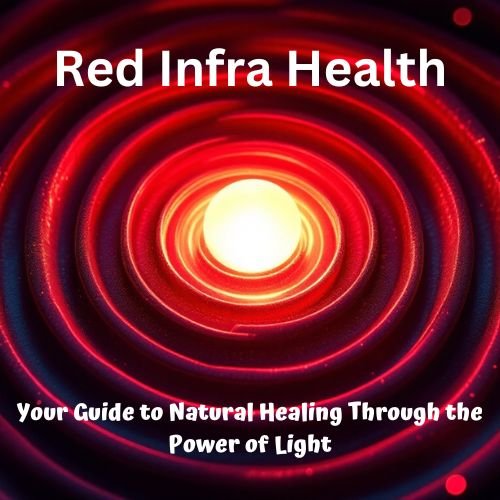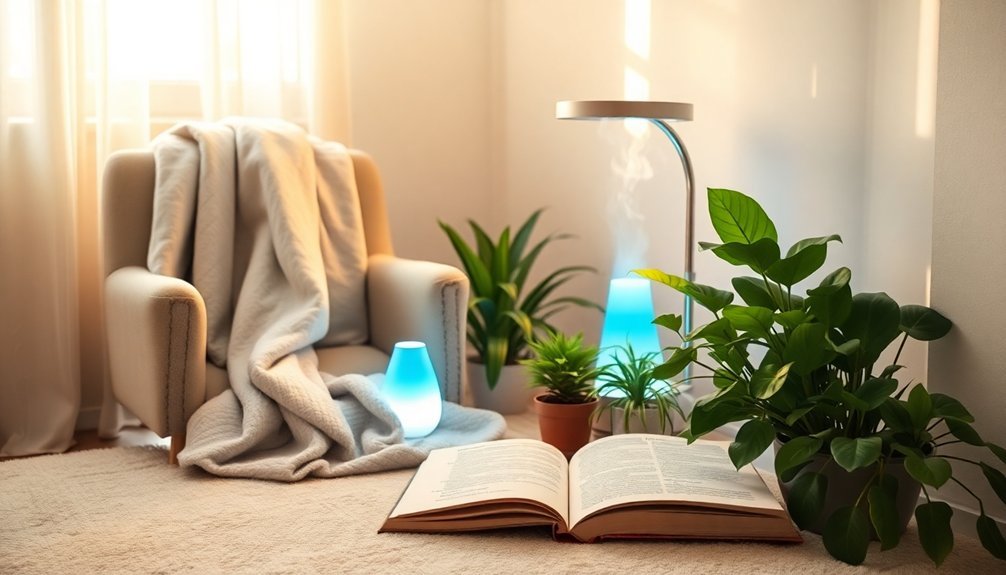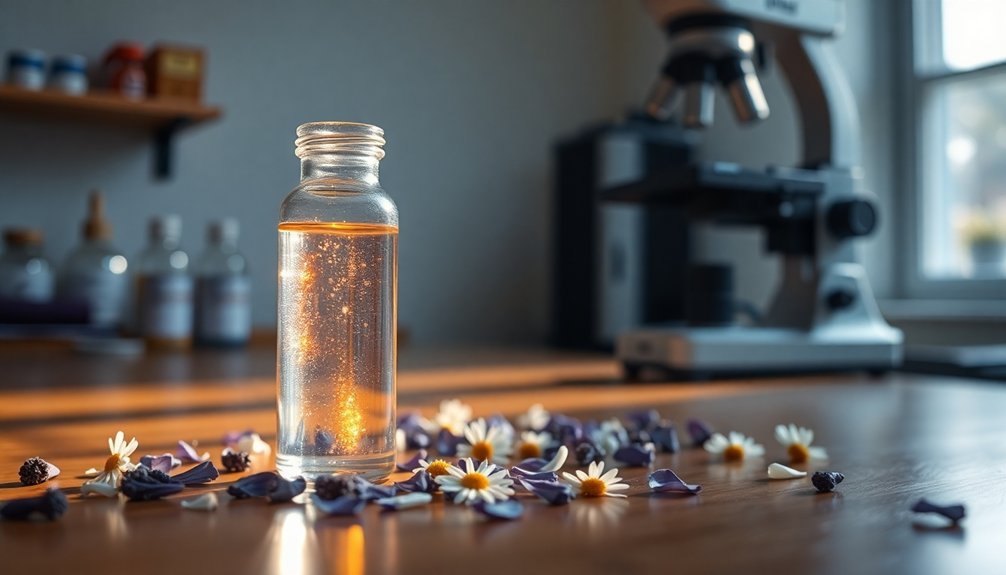Morning light therapy can substantially improve your winter depression symptoms by regulating your body's internal clock and boosting serotonin production. When you use a light box that emits 10,000 lux for 30-45 minutes each morning, you'll help reset your circadian rhythm, enhance your mood stability, and increase your energy levels. You'll likely notice reduced fatigue, better sleep patterns, and improved mental clarity. This treatment works especially well when combined with other approaches like exercise and counseling. The science behind morning light therapy offers a bright path forward for managing seasonal mood changes.
Understanding Winter Depression

Winter's grip on mental health can manifest as a serious form of depression that follows a distinct seasonal pattern. When you experience winter depression, you'll notice symptoms emerging in late fall or early winter, with relief typically coming in spring or summer. This isn't just a case of the "winter blues" – it's a substantial condition that can severely impact your daily life.
You might find yourself feeling listless and sad throughout most of the day, losing interest in activities you once enjoyed. The physical symptoms are particularly telling: you'll likely experience persistent fatigue, oversleeping, and strong cravings for carbohydrate-rich foods, often leading to weight gain.
Concentration becomes a challenge, and your energy levels drop markedly. Living far from the equator can increase your risk of developing these seasonal symptoms.
What sets winter depression apart from typical winter blues is its profound effect on your functioning. You may struggle with maintaining relationships, performing at work or school, and managing daily tasks.
The condition can trigger feelings of hopelessness, worthlessness, and guilt. In severe cases, you might experience thoughts of not wanting to live.
If you notice these symptoms following a seasonal pattern, it's essential to recognize them as signs of a major depressive disorder requiring professional attention.
Benefits of Light Therapy
Light therapy stands as one of the most effective treatments for winter depression, working by mimicking the natural sunlight your body craves during darker months. When you're exposed to therapeutic light, it helps regulate your body's production of serotonin and melatonin, essential hormones that influence your mood and sleep patterns. Women during childbearing years are particularly responsive to light therapy due to their heightened susceptibility to SAD.
You'll find these key benefits when using light therapy consistently:
- Improved sleep-wake cycle, helping you maintain a healthier circadian rhythm even during the darkest winter days
- Enhanced mood stability through balanced hormone levels, particularly serotonin
- Reduced lethargy and excessive sleepiness, common symptoms of winter depression
- Better overall energy levels and mental clarity throughout the day
You can easily incorporate light therapy into your morning routine using a light box at home, though it's important to choose one with the right intensity (between 2,500 and 10,000 lux).
While light therapy is generally safe, you'll want to consult your healthcare provider before starting, especially if you have bipolar disorder or eye conditions. The treatment works best when used consistently and can be combined with other approaches like antidepressants or psychotherapy for maximum effectiveness.
Morning Light Effects

The science behind morning light exposure reveals why it's particularly powerful for treating winter depression. When you receive bright light in the morning, it triggers a vital process called circadian phase advance, which helps reset your body's internal clock. This timing is essential because winter depression often involves a delayed circadian rhythm that needs correction.
Your body responds to morning light therapy in several specific ways. It shifts your melatonin onset to an earlier time, which helps regulate your sleep-wake cycle more effectively. You'll find this particularly beneficial because it's more effective than evening light exposure for improving depressive symptoms. Depression scores dropped 37% with morning light treatment compared to pretreatment levels.
The treatment works by influencing both your serotonin and melatonin levels, which are typically disrupted when you're experiencing winter depression.
Research shows that you'll get the best results by using a light box that emits 10,000 lux for 30-45 minutes each morning. You'll need to maintain consistency with your treatment, as regular exposure is key to its effectiveness. The size of the phase advances in your melatonin onset directly correlates with how well you'll respond to the treatment, making morning timing essential for success.
Treatment Timing and Duration
Successful treatment of winter depression depends on three critical timing factors: when you start your daily sessions, how long each session lasts, and the overall duration of your therapy program. Research shows that morning light therapy is more effective than evening sessions, as it helps advance your circadian rhythm and better regulates melatonin production.
For the best results, you'll want to structure your treatment following these key guidelines:
- Schedule your light therapy sessions in the morning hours, as this timing creates a beneficial phase-advancing effect on your circadian rhythm
- Plan for sessions lasting 1-2 hours, using high-intensity light (at least 2,500 lux)
- Commit to a minimum two-week treatment program to see a meaningful reduction in depression scores
- Consider incorporating morning walks in natural daylight as a complementary treatment
You're more likely to respond well to this treatment schedule if you're younger and experience symptoms like oversleeping and increased appetite. Studies suggest that people living in areas far from the equator may particularly benefit from structured morning therapy sessions.
While individual responses vary, consistent morning exposure proves most effective for most people with winter depression, helping reset your body clock and improve your symptoms.
Choosing Your Light Device

Now that you've established an ideal treatment schedule, selecting the right light therapy device will determine your treatment's effectiveness. Look for a device that emits 10,000 lux and features full-spectrum fluorescent light to properly mimic natural sunlight.
The color temperature should fall between 5,000 and 7,000 K for ideal daylight simulation.
You'll find various options available, with light boxes being the most common choice for SAD treatment. Choose a device with adjustable brightness settings to accommodate your comfort level and treatment needs. Remember that lower brightness settings will require longer treatment sessions.
While specific colored lights exist for other conditions, they're not recommended for SAD treatment.
Before making your purchase, consult with your healthcare provider, especially if you have eye conditions or bipolar disorder. While you don't need a prescription to buy a light therapy device, professional guidance guarantees you'll select one that meets your specific needs.
When shopping, you'll notice different sizes and price points available. Don't let insurance coverage influence your decision, as most plans don't cover these devices. Instead, focus on finding a quality device that matches the recommended specifications.
Common Treatment Mistakes
Making treatment mistakes when addressing winter depression can substantially delay your recovery and worsen symptoms. One of the most critical errors is failing to get proper medical guidance before starting any treatment plan. Without professional assessment, you might miss underlying conditions or choose inappropriate therapies that won't effectively address your symptoms.
Light therapy mistakes are particularly common among those treating winter depression. If you're not using a SAD-specific light box or following recommended timing and duration guidelines, you'll likely see reduced benefits. Additionally, improper placement or ignoring potential side effects like eye strain can make your treatment less effective.
Consider these essential aspects to avoid common pitfalls:
- Don't skip professional assessment – work with a healthcare provider to develop a thorough treatment plan
- Follow light therapy protocols precisely, including correct timing, duration, and device positioning
- Monitor medication effectiveness if prescribed, and report any concerns to your doctor
- Maintain a holistic approach by incorporating lifestyle changes, proper sleep hygiene, and stress management techniques
Remember that consistent therapy throughout winter months is vital, and don't overlook the importance of vitamin D levels and social support in your recovery process.
Combining Multiple Treatment Approaches

You'll get the most effective results from winter depression treatment by combining morning light therapy with professional counseling sessions.
When you add regular exercise to your routine, especially morning walks in natural sunlight, you're creating a powerful three-pronged approach to managing seasonal symptoms.
These treatments work together to boost your mood, regulate your sleep cycle, and give you practical coping strategies for the darker months.
Therapy Plus Light Treatment
Research has consistently shown that combining light therapy with other treatments can substantially enhance outcomes for winter depression sufferers. You'll find that combination approaches, particularly light therapy with fluoxetine, achieve remarkably high response rates of 75.9% and remission rates of 58.6%.
When you're considering treatment options, it's worth noting that this combined approach demonstrates a more significant effect in reducing depressive symptoms compared to using either treatment alone.
Here's what you should know about therapy plus light treatment:
- Morning light therapy combined with CBT-SAD offers long-lasting benefits, with therapeutic effects extending well beyond the treatment period.
- You won't face increased side effects when combining treatments – studies show no significant differences in adverse events between combination therapy and single treatments.
- If you experience symptoms like oversleeping and increased appetite, you're more likely to respond positively to light therapy.
- Your healthcare provider might recommend starting with light therapy alone, then adding other treatments if needed, as light therapy proves effective regardless of whether it's used alone or combined.
This combination approach is particularly valuable if you haven't responded well to single treatments in the past.
Exercise With Morning Sunlight
Three powerful allies in fighting winter depression converge when you combine exercise with morning sunlight exposure. When you exercise outdoors in the morning, you'll benefit from natural light hitting your retinas, increased serotonin production from both the sunlight and physical activity, and a reset of your circadian rhythm that helps regulate your sleep-wake cycle.
You don't need intense workouts to reap these benefits. A 30-minute brisk walk during morning hours can markedly impact your mood and energy levels. By exercising outdoors when the sun is up, you're effectively combining two non-pharmaceutical treatments that complement each other in managing seasonal depression symptoms.
The timing of this combination therapy is pivotal. Morning sunlight is particularly effective in enhancing alertness and regulating your biological clock. When you pair this with moderate exercise, you're creating a powerful intervention that can help stabilize your mood throughout the day.
For ideal results, aim to get 30-60 minutes of morning sun exposure while engaging in physical activity. This approach aligns with your body's natural rhythms and can lead to substantial improvements in managing winter depression symptoms.
Daily Wellness Habits
Maintaining a strong defense against winter depression calls for a structured set of daily wellness habits that work together to elevate mood and energy levels. Your daily routine should integrate light therapy with proper nutrition, regular exercise, and consistent sleep patterns to maximize effectiveness against seasonal symptoms.
Start your mornings with 20-30 minutes of light therapy using a specialized light box while you meditate or exercise.
You'll want to maintain a balanced diet rich in Omega-3 fatty acids, vitamin D, and whole grains, keeping regular meal times to support your body's natural rhythms.
Create a sleep environment that's dark, quiet, and cool, and stick to consistent bedtimes to regulate your circadian rhythm.
Here's how to structure your daily wellness routine:
- Begin with morning light therapy combined with gentle stretching or meditation
- Follow a nutrient-rich meal plan with regular eating times
- Get 30 minutes of daily physical activity, preferably during daylight hours
- Maintain social connections through regular community activities or scheduled catch-ups
Don't hesitate to seek professional guidance if these habits aren't providing sufficient relief from your winter depression symptoms.
Frequently Asked Questions
Can Light Therapy Cause Eye Damage or Vision Problems Over Time?
Yes, you can develop eye damage from light therapy over time. Blue light exposure can harm your retina and increase your risk of age-related macular degeneration, especially if you're older or take certain medications.
Will Light Therapy Still Work if I Take Medications for Depression?
Yes, you can safely use light therapy while taking depression medications. In fact, it often works better when combined with antidepressants, potentially giving you faster relief and better results than using either treatment alone.
Should I Continue Light Therapy During Summer Months?
You typically won't need light therapy during summer months when natural sunlight is abundant. However, consult your healthcare provider, as individual needs vary. Some people may benefit from continued use year-round.
Can Pregnant Women Safely Use Light Therapy for Winter Depression?
Yes, you can safely use light therapy while pregnant. Studies show it's effective for treating winter depression with no reported risks to you or your baby. Still, it's best to consult your doctor first.
Does Skin Color or Eye Color Affect Light Therapy Effectiveness?
No, your skin color and eye color don't affect light therapy's effectiveness. You'll get the same benefits regardless of these factors, as the therapy works through your eyes' photoreceptors to regulate your biological clock.
In Summary
You've got powerful tools at your disposal to fight winter depression through morning light therapy. When you're consistent with your daily morning sessions, combine them with other treatments, and follow proper timing guidelines, you'll boost your mood and energy levels. Don't forget to choose the right light device and maintain healthy daily habits. With these strategies, you can effectively manage seasonal depression symptoms throughout winter.





Leave a Reply